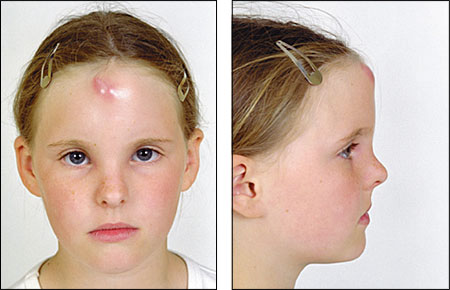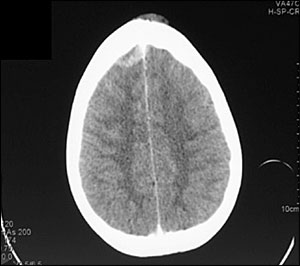
Am Fam Physician. 2007;75(2):243-244
A 10-year-old girl presented with a one-week history of a lump on her forehead. It was initially thought to be an infected sebaceous cyst (Figure 1). Review of symptoms revealed a three-month history of nasal discharge and frontal headaches but was otherwise negative. She had been diagnosed previously with sinusitis and treated with a two-week course of amoxicillin.

Question
Discussion
The answer is D: Pott's puffy tumor. In children, bacterial sinusitis may complicate an upper respiratory tract infection. In most cases, this resolves without further problems. Frontal osteomyelitis secondary to frontal sinusitis (Pott's puffy tumor) is rare in the antibiotic era,1,2 but it can result in serious consequences.
Patients present with frontal scalp swelling and also may have headache, fever, nasal drainage, and frontal sinus tenderness. If the condition progresses, neurologic complications such as hemiparesis, obtundation, pupillary dilatation, aphasia, or intracranial abscess can develop.1 Early diagnosis can be achieved with the use of computed tomography3 (Figure 2). Contrast-enhanced magnetic resonance imaging may be necessary to rule out intracranial empyema.4

A carbuncle is a simple skin infection that is locally painful and tender. It would not cause headaches or nasal discharge and would be uncommon in a healthy young girl. Carbuncles often discharge pus from multiple sites.
A sebaceous cyst is usually evident to the patient as a painless lump. Furthermore, it should be present for a while before becoming infected. Cysts also may rupture, causing an intense inflammatory reaction that is difficult to distinguish from an acute infection.
The history given by the patient and her mother was not suspicious for a hematoma. There were no surrounding ecchymoses, and the overlying skin was intact. Furthermore, she had no history of trauma or coagulopathy.
There was no previous exposure to or inoculation with tuberculosis or a history of foreign travel. The patient was previously healthy and was not immunocompromised. Cutaneous tuberculosis would not be associated with symptoms of headache or nasal discharge.
| Condition | Characteristics |
|---|---|
| Carbuncle | Painful and tender swelling of the skin caused by bacterial infection (commonly Staphylococcus aureus); may be fluctuant and/or discharge pus; there is often surrounding inflammation or cellulitis |
| Infected sebaceous cyst | Common in hair-bearing skin, especially over the face, neck, and trunk; usually slow-growing and painless but will become painful if infected |
| Hematoma | Associated with a history of trauma and most likely to have a sudden onset of swelling after injury; a surrounding area of ecchymosis may be visible |
| Pott's puffy tumor | Frontal scalp swelling caused by frontal osteomyelitis with a bone defect and an epidural collection; symptoms include headache, fever, nasal drainage, and frontal sinus tenderness; if the condition progresses, neurologic complications may develop |
| Inflammatory cutaneous tuberculosis | Low incidence; most often occurs in endemic areas; more common among immunocompromised patients |